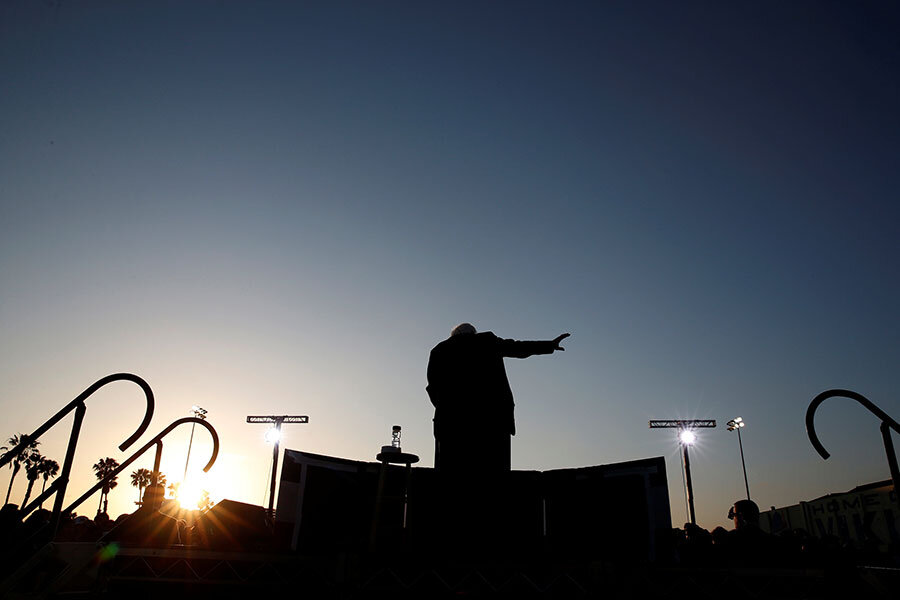A hint that, in the end, Sanders might work with Democratic Party
Loading...
This week, Bernie Sanders offered a hint that, as he seeks to turn his legions of rabid supporters into a movement, he might work from within the Democratic Party.
Senator Sanders’s intentions have not always been plain. For much of the past month, he has thrown stones at the Democratic establishment.
Speaking in California earlier this month, after a violent outburst from his supporters at the Nevada Democratic convention, he called on the party leadership to “open the doors, let the people in,” or “remain dependent on big money campaign contributions, and be a party with limited participation and limited energy.”
But a compromise struck this week with Hillary Clinton gives him some influence in crafting the party’s political platform. Seeking more control of the party platform does indicate a willingness to try and effect change within the traditional party process.
It is part of a calculation Sanders will have to make as the Democratic convention nears and party partisans remain – at least for now – firmly behind Mrs. Clinton.
“He’s not really doing a lot to try to quell some of the division and concern, and he’s going to need to step up at some point,” says Mo Elleithee, executive director of Georgetown University's Institute of Politics and Public Service, and who spent two decades as a communications strategist for the Democratic Party. “What are they looking for at this point? Disruption for the sake of disruption, or fighting for something bigger?”
Five members of the 15-member platform-drafting committee will be Sanders appointees, while Clinton has chosen six, and party chairwoman Debbie Wasserman Schulz has chosen four. While his faction won’t control the committee, he should be able to get some of his ideas enshrined in the official party platform for four years.
The party platform is “commonly controlled by the party leadership and the leading candidate,” says David Hopkins, a political scientist at Boston College. “From his point of view, the platform is one place where he can get a tangible influence on proceedings.”
In this way, Sanders may be sidestepping a trap that has caught antiestablishment Democratic candidates in the past. Candidates like George McGovern (1972), Jerry Brown (1992), and Howard Dean (2004), all pitched their campaigns as grass-roots movements against the entrenched political elite. But as their vocal supporters were outnumbered out by the rest of the electorate, they turned to procedural critiques – in particular, the outsized influence of money in political campaigns.
To some critics, such charges resonate only with a narrow slice of the Democratic electorate – namely white and college-educated voters.
“Like Dean or Bradley before him, Sanders is a factional candidate of ideological liberal Democrats, who are largely white Democrats,” writes Jamelle Bouie of Slate. “While that minority is larger and stronger than it’s been in a generation, it’s still not strong enough to steer the party alone. It still has to play coalition politics.”
There is some potential for conflict, however, looking at Sanders’ choices for the committee. They include James Zogby, president of the Arab-American Institute and a longtime activist for Palestinian rights, and Cornel West, the African-American intellectual and a fierce critic of President Obama.
“I don’t think everyone is going to be on same page,” says Thomas Whalen, a social science professor at Boston University, and an expert on presidential campaigns. “That’s more time and attention paid to it than in the past.”
Traditionally, drafting the party platform has been a way for political parties to heal after intense primary campaigns and form a united front for the general election. That will hinge on how Sanders interprets the platform and how he transmits that to his supporters.
In 2008, Clinton chose to support Barack Obama after narrowly losing the nomination to him, preserving her own political aspirations. But this is likely Sanders’ one moment in the national spotlight.
Given all these variables, the drafting of a political party platform – usually a wonkish process – could actually generate public interest.
“It’s [normally] not he biggest area of focus,” says Steve Kerrigan, a longtime Democratic strategist who was CEO of the 2012 Democratic convention. ““There will be more time and attention paid to it than in the past.”








